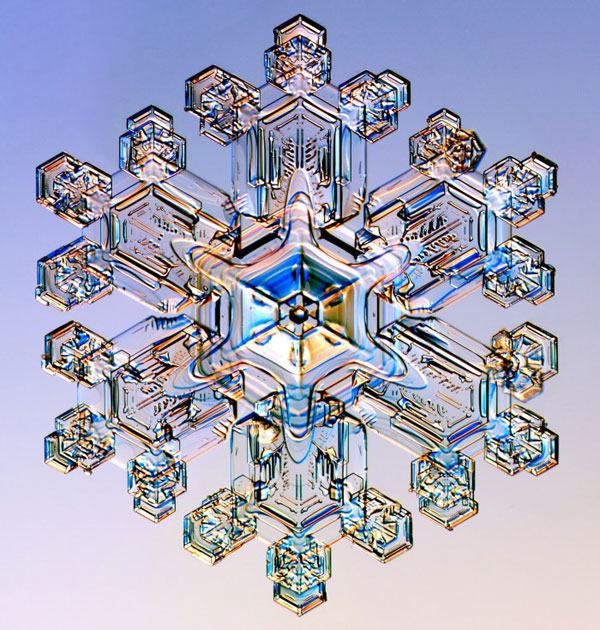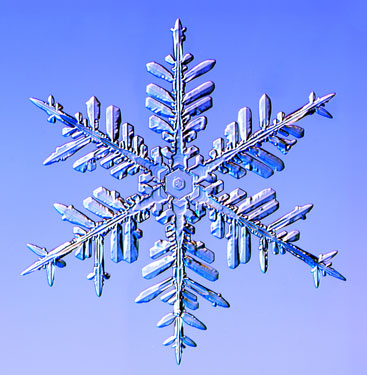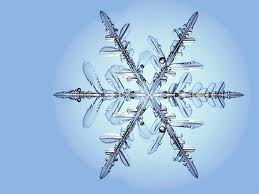Snowflakes under the microscope


If you look closely at falling snow, you can see a great many different crystal shapes. There’s a lot more to see than you might think!
Photographing snowflakes can be great fun and a rewarding hobby. It is a quiet, contemplative activity that takes you outdoors on snowy days to examine and record some of Nature’s most stunning artistry. Best of all, each picture you take will be different from all others, because each snow crystal is unique.
Unfortunately, snowflake photography is not cheap, and it requires that you to spend some quality time outside in the cold. But if snowmobiling (which is also mighty cold and expensive) is not for you, then you may want to give snowflake photography a try. Before spending a lot of money on photographic equipment, I suggest that you first try some basic snowflake watching. Carry a small magnifier around in your pocket for a little while and see what the crystals look like where you live. If you like what you see and want to go further, then consider buying a microscope or going full-on and building your own snowflake photography set-up. Snow crystals are small, somewhat fragile, and they melt away with the slightest breath.
The crystals also tend to evaporate away or melt once they’re under the lights of the microscope. This means you only have a few minutes to bring the crystal into view and compose the shot.
A good strategy for handling larger snow crystals is to first catch them as they fall on some convenient cold flat surface. Any dark-colored cardboard surface works well, and I find blue foam-core is nearly ideal. Scan the board for interesting crystals, and brush the flakes off regularly. When you spot a good one, carefully pick it up using a tiny paintbrush (say 1mm diameter brush, with a sharp tip) and place it on a clean microscope slide. Place the slide under your microscope and take the picture.
Temperature matters a lot. If it’s just a few degrees below freezing, snowflake photography is difficult. The crystals melt almost as soon as you look at them. When it’s colder, the crystals are easier to handle and they last longer, giving you more time to compose. I get my best pictures when the temperature is around -15 C (5 F), which is where stellar plates form (see the Morphology Diagram).
Another technique I like is to simply let snowflakes fall on clean microscope slides. Support 2-8 slides by their edges so you don’t get icy glop on the lower surfaces. When a slide has a nice dusting of snow, put it under the microscope and scan around for nice crystals. When you’ve seen what one slide has to offer, wipe it off, place it back outside, and pick up another. I’ve taken many excellent pictures of smaller snow crystals using this simple technique.
Snow crystals are made of ice, which is clear and colorless. If you look closely at falling snow, you can see a great many different crystal shapes. There’s a lot more to see than you might think!A hexagonal prism is the most basic snow crystal geometry (see the Snowflake Primer). Depending on how fast the different facets grow, snow crystal prisms can appear as thin hexagonal plates, slender hexagonal columns (shaped a lot like wooden pencils), or anything in between. Simple prisms are usually so small they can barely be seen with the naked eye. Stellar plates often show distinctive ridges that point to the corners between adjacent prism facets. When these ridges are especially prominent, the crystals are called sectored plates. Dendritic means “tree-like”, so stellar dendrites are plate-like snow crystals that have branches and sidebranches. These are fairly large crystals, typically 2-4 mm in diameter, that are easily seen with the naked eye.Sometimes the branches of stellar crystals have so many sidebranches they look a bit like ferns, so we call them fernlike stellar dendrites. These are the largest snow crystals, often falling to earth with diameters of 5 mm or more. In spite of their large size, these are single crystals of ice — the water molecules are lined up from one end to the other.Some snowfalls contain almost nothing but stellar dendrites and fernlike stellar dendrites. It can make quite a sight when they collect in vast numbers, covering everything in sight. And many more shapes.















Kenneth G. Libbrecht
Valuable info. Lucky me I found your site by accident, I bookmarked it.
Amazing snowflakes pics
Good afternoon
I would like to get in touch with the owner, photographer, or author of snowflake #11, because im working on a proyect and id like to use certain image and get the rights or permission to use it.
thank you
have a nice day
Beautiful!